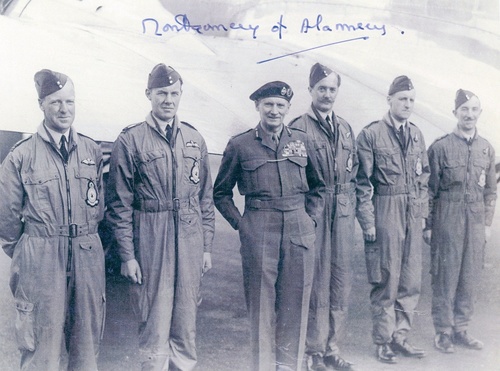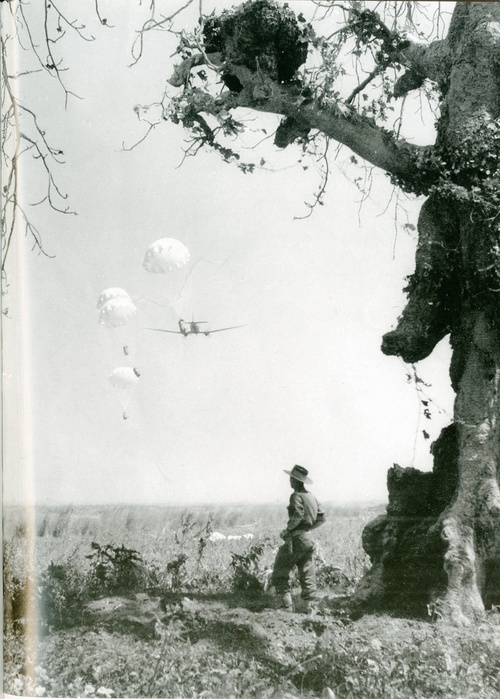Auction: 17003 - Orders, Decorations and Medals
Lot: 720
'Generally we aircrews were kept in the dark about who we were dropping to, in case of a forced landing and being captured and interrogated by the Japanese. We'd heard all about their horrific treatment of prisoners, alive or dead. They seemed to think that killing just wasn't enough … We thought about that on the long-range sorties we did that summer of '43, down on the Arakan front.'
Warrant Officer Colin Lynch, a Navigator in Dakotas of No. 31 Squadron, describes one of numerous nightmare scenarios facing him and his gallant supply-aircrew; Burma Drop Zone, refers.
An outstanding Second World War Burma 'down the chimney' operations D.F.C. group of six awarded to Squadron Leader G. W. Buckland, Royal Air Force, late Royal Air Force Volunteer Reserve, a Navigator who completed 330 operations in Dakotas of No. 31 Squadron in the period July 1943 to June 1945
Regular supply drops to Tiddim, Kohima and Imphal aside, he also acted in direct support of Orde Wingate's Chindits in Operation "Thursday" in early 1944, a perilous period of active service vividly documented in the pages of Roger Annett's Drop Zone Burma
Distinguished Flying Cross, George VI, the reversed officially dated '1945', with its Royal Mint case if issue; 1939-45 Star; Burma Star; Defence and War Medals 1939-45; General Service 1918-62, G.VI.R., 1 clasp, Malaya (Sqn. Ldr. G. W. Buckland, R.A.F.), together with an R.A.F. sweetheart's brooch, good very fine and better (6)
D.F.C. London Gazette 6 November 1945. The original recommendation states:
'A Navigator of outstanding merit who throughout his two tours on the Squadron - without rest - has shown that his heart and soul was in flying in the particular job of work in hand and it was with the greatest reluctance that he left active flying duties on being posted to a Staging Post for briefing duties. As one of the Squadron's oldest Navigators he took part in some of the most historic operations of this war, including the first (sic) Chindit operation, the siege of Imphal, and also the supply of the Army along the Tiddim Road. I have no hesitation in strongly recommending him for an award.'
Geoffrey Walter Buckland enlisted in the Royal Air Force Volunteer Reserve at Lord's cricket ground, London in September 1941 and was embarked for training in South Africa in the following year. On qualifying as a Navigator in March 1943, he was embarked for India, where he joined No. 31 Squadron, a Dakota unit, in July.
'Down the chimney'
A quite remarkable wartime career ensued, for by the time of him being recommended for his D.F.C. in June 1945, he had completed no less than 330 operational sorties, 240 of a supply-dropping nature and 90 of a supply-landing nature.
As related by Roger Annett in Drop Zone Burma, 31 Squadron carried out the lion's share of supply drops throughout 1943:
'The heavy workload of sorties continued throughout the year in the most hazardous flying conditions imaginable - monsoon weather and thunder-cloud turbulence, mountains up to 8,000 feet, and enemy fighters and ground fire.'
In Drop Zone Burma, Warrant Officer Colin Lynch - like Buckland a Navigator in 31 Squadron - describes the realities of enemy ground fire. He relates how his Dak was 'often hit by gunfire and landed with bullet holes in the airframe - once we got a hole as big as your fist from mortar shell fire'. He also describes a tragic encounter with Oscar fighters over Tiddim in late November 1943. The enemy aircraft attacked his Dakota as it approached the DZ at 300 feet, the resultant fire shooting past it and hitting another Dakota, piloted by Flight Sergeant Richards: this broke away, hit a cliff and blew up.
By mid-January 1944, Buckland had completed his first tour of duty - totalling 500 hours of operational flying. He immediately volunteered for a second tour, a tour that included direct support to Orde Wingate's Chindits in Operation "Thursday" in March 1944. In this period Buckland's log book notes all manner of sorties, flying-in mules, jeeps and troops, and evacuating casualties.
Of these Chindit trips, Lynch recalls the occasion his Dak overshot the Chindit jungle airstrip at "Aberdeen" and hit a rocky mound. The aircraft was a write-off and he and his crew found themselves in the midst of a Japanese assault in the early morning hours - 'people were killed, on both sides, but they somehow missed us'. For his own part, Buckland's log book reveals similar trips to the jungle airstrip at "Broadway", where landing conditions were equally hazardous. Meanwhile, unlike Japanese A.A. fire, the weather was breaking up:
'The weather was continuing to deteriorate and the pouring rain, low cloud and turbulence, together with the terrain, made sorties to the Chindits perilous in the extreme. On 24 March, Wingate himself was killed in an air crash, caught in a storm when flying to India to report. Supply dropping flights could only be made because the Allied air forces had established air superiority over the Japanese, but there was still anti-aircraft fire - slow moving Daks, at low level, made an easy target' (ibid).
In April 1944, Buckland, Lynch and fellow aircrew were diverted to the assistance of the gallant defenders of Kohima. Lynch would recall:
'On both sides of the ridge, the mountains rise up another thousand feet or so and that's where the Japs were, lobbing their shells and mortar bombs into our troops. We had to run the gauntlet to make the drop. There'd usually be a line of Daks going in, one after the other. We dropped them everything you could think of - but mostly ammo, rations and medical supplies. And after the monsoon started we dropped them a load of tarpaulins so they could catch some water. There wasn't much of a DZ even from the start, and as the siege went on, we got down to dropping on what used to be the District Commissioner's tennis court. By then, there wasn't anything much of the place left standing. The trees had all been blasted and were smothered in white parachutes' (ibid).
It was a haunting scene, shared by Buckland, who made several trips to Kohima. Peter Bray, another pilot in 31 Squadron, recalled:
'The ghastly thing was that we could see it all as we went in on our runs. There were our lads, dug in just a shovel's length from the Jap trenches. Dead bodies lying all around, and wounded crawling back from No Man's Land. And there'd been a hospital there - horrible. What those men suffered doesn't bear thinking about. I'd never seen anything so dreadful and I'd never want to see such things again' (ibid).
Buckland completed his second tour of duty on the last day of June 1944, by which time he had amassed 935 hours of operational flying. But in November 31 Squadron was again called to frontline duties, and as a result he added hundreds of hours to his tally operational tally in the 'race for Rangoon'.
He was awarded the D.F.C. and repatriated to the U.K. at the year's end.
Postscript
Buckland obtained a regular commission in the R.A.F. at the war's end, initially with an extended appointment in No. 24 Squadron. It was in this capacity that his crew flew Field Marshal Montgomery from Northolt to Belgium in September 1947; sold with copied signed photograph marking the event.
He subsequently served as a Squadron Leader in Far East Command in the 1950s, including a tour of duty in Malaya (Medal & clasp). His final appointment was at R.A.F. Scampton in the early 1960s.
Sold with the recipient's original S.A.A.F. 'Observer's or Air Gunner's Log Book', covering the period August 1942 to May 1947 and his R.A.F. Navigator's, Air Bomber's, Air Gunner's and Flight Engineer's Flying Log Book, covering the period June 1947 to February 1962, the first a victim of 'climatic conditions' and therefore distressed; together with the recipient's Buckingham Palace D.F.C. forwarding letter in the name of 'Flight Lieutenant Godfrey W. Buckland, D.F.C.', and his R.A.F. Navigation Warrant (Second Class), dated 31 December 1946.
Subject to 20% VAT on Buyer’s Premium. For more information please view Terms and Conditions for Buyers.
Sold for
£2,200









